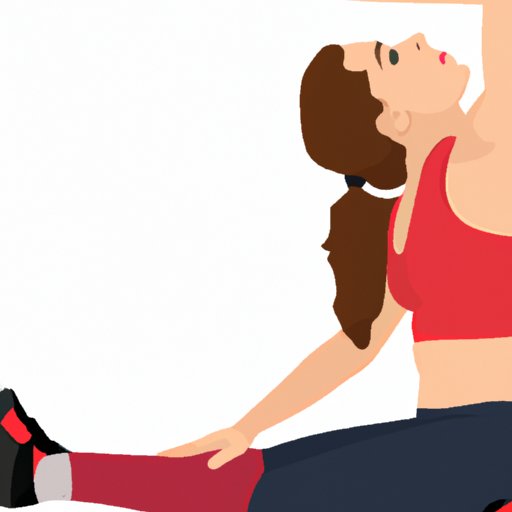
I. Introduction
Welcome to the ultimate guide to stretching your hamstrings. If you are someone who likes to stay fit and active, then this article is for you. The hamstrings are a group of muscles located at the back of the thigh, running from the pelvis to the back of the knee. Tight hamstrings can cause discomfort, inefficiency and can even lead to injuries, but proper stretching can help improve flexibility, range of motion, and reduce the risk of injury. This article will provide you with a step-by-step guide to the best hamstring stretches, benefits of regular hamstring stretches, the importance of stretching before and after a workout, common mistakes to avoid while stretching your hamstrings, and ways to improve your hamstring flexibility.
II. A step-by-step guide to the best hamstring stretches
Before starting any form of physical activity or stretching exercises, it is always essential to warm up by walking or jogging for a few minutes. Here are some of the most effective hamstring stretches:
- Hamstring stretch: It involves lying on your back with your legs flat on the ground, then lifting one leg and gently pulling it towards your chest with both hands. Hold the stretch for 10-30 seconds, then switch legs.
- Standing hamstring stretch: Stand with your feet hip-width apart, take a half step forward with one foot. Raise the leg at the front with a straight knee, and bend the opposite leg slightly. Reach for the toes of the elevated leg, and hold the stretch for 10-30 seconds. Repeat with the other leg.
- Knee-to-chest stretch: Lie on your back and bend your knees, placing both feet on the ground. Take one knee and pull it towards your chest, holding it with both hands behind your knee. Hold the stretch for 10-30 seconds and repeat with the other leg.
Make sure to follow these tips for safe and effective hamstring stretching:
- Stretch until you feel mild tension, not pain.
- Don’t hold your breath while stretching.
- Stretch both legs equally.
- Do not bounce or jerk during the stretches.
- Hold each stretch for at least 10-30 seconds.
III. What are the benefits of regular hamstring stretches
Regular hamstring stretching helps in reducing lower back pain, promoting proper posture, improving range of motion, reducing muscle tension and increasing overall flexibility. Studies have also found that stretching can reduce instances of severe injuries to muscles, including hamstring strains. Stretching improves blood circulation, which helps in supplying oxygen and nutrients to the muscles and assists them in recovering faster.
IV. The importance of stretching before and after workout
Stretching before and after exercise is as equally important as the regular stretching. It helps prepare the body for the workout and aids in recovery afterwards. Proper stretching before the workout can increase performance, reduce the risk of injury and improve range of motion. Here are some effective pre- and post- workout stretches:
- Pre-workout: Begin with a gentle, full-body warm-up such as jogging on the spot for a few minutes. Once you are warmed up, do dynamic stretches such as leg swings, jumping jacks and lunges to help activate your muscles before the workout.
- Post-workout: Once the workout is complete, do some static stretches to help cool down your body. It is vital to hold each stretch for at least 20-30 seconds. Include exercises such as hip flexor stretch, standing hamstring stretch and quad stretch.
V. Common mistakes to avoid while stretching your hamstrings
Mistakes can be made even during the most basic stretching routines, and these mistakes can be dangerous. Here are some of the common mistakes you should avoid:
- Bouncing or stretching too far: This can cause your muscles to overstretch, leading to pain and discomfort.
- Holding your breath: It is easy to hold your breath while stretching without even realizing. Always remember to breathe deeply and avoid holding your breath.
- Not stretching regularly: Stretching daily is essential in keeping your muscles flexible and reducing the risk of injury.
VI. How to improve your hamstring flexibility
If you are looking to improve your hamstring flexibility, include some of these exercises:
- Dynamic stretching: Dynamic stretching utilizes a full range of motion movements, activating muscles throughout the range of motion, and reduces the risk of muscle pull or strain.
- Resistance bands: Using resistance bands as part of your exercise routine can help in improving flexibility and strength.
- Foam rolling: Foam rolling or self-myofascial release is a technique used for effectively massaging your muscle fibers.
Incorporate these exercises into your routine for a few weeks, and track your progress. Consistency is key to improving hamstring flexibility.
VII. Conclusion
Stretching is an essential part of a healthy and active lifestyle. Regular stretching can help improve muscle flexibility, relieve soreness and tension and prevents injuries. A regular stretching regime, paired with proper precautions, can help guarantee a healthy and active life. Adding hamstring stretching to your workout routine can be significant. Just remember to take precautions, avoid common mistakes, and never push your muscles too far.




